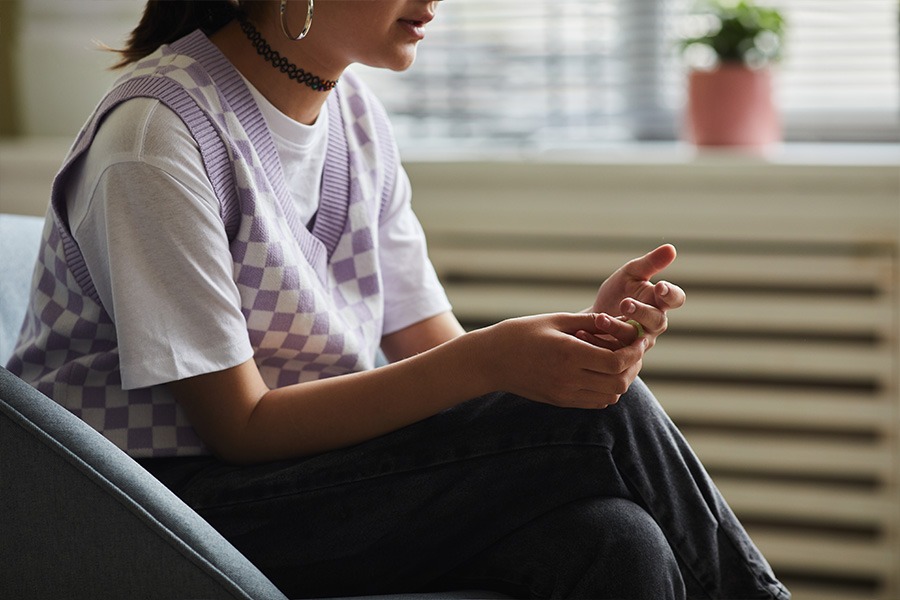Ridge Residential Adolescent & Teen Bipolar Treatment Centers
The teenage years are an extremely trying time for any person, and mood swings are common thanks to naturally occurring hormonal increases and stabilization. However, if you notice your teen’s moods swinging from extreme happiness to severe gloominess on a more-or-less regular basis, there may be cause for concern.
Bipolar disorder affects 2.9% of adolescents in the U.S., causing significant emotional highs and lows. While not curable, proper treatment can ensure a healthy future!
Our teen bipolar disorder treatment programs cater to those aged 12-18, both along the East Coast AND nationwide. Keep reading for an overview of what bipolar disorder is, including symptoms to look out for and steps you can take to help your child feel more like themselves.

Residential Bipolar Treatment at Ridge RTC
Ridge RTC is a short-term residential treatment program with campuses located in the southeastern part of New Hampshire and coastal Maine. Our unique approach to teen mood disorder treatment and therapy makes us a leading option for adolescents in need of comprehensive assistance, including those who are struggling with bipolar disorder.
Our primary focus is your child’s well-being, both while they’re attending a Ridge RTC residential bipolar treatment center and in their future endeavors. On-staff includes licensed and board-certified psychiatrists as well as experienced RNs (registered nurses) who specialize in teenage mental health care. Academics and tutoring are open to those who seek it.
Healthy living is encouraged within our therapeutic programs for young adults in Maine and New Hampshire. To support these efforts, patient itineraries include physical activities, balanced diets, local volunteering, cultural excursions, and nature expeditions. We also offer holistic activities that support our broader mental health treatment services, such as yoga, mindfulness sessions, music, arts, and much more.
Ridge RTC is an excellent option for teens learning to manage or overcome mental health struggles such as bipolar disorder, with safe and serene teen bipolar treatment centers designed to feel as comfortable as home.
What Is Bipolar Disorder?
Bipolar disorder is a chronic and severe mental illness that afflicts an estimated 4.4% of Americans at some point in their lifetime – and it usually rears its ugly head during late teens or early adulthood.
Individuals with bipolar disorder tend to alternate between two extremes: manic episodes and depressive episodes. Manic episodes are periods when someone suffering from bipolar disorder becomes extremely happy and active. Depressive episodes are periods of intense sadness and usually fill in the gaps between manic episodes. That being said, some individuals with bipolar disorder only experience manic episodes and do not experience depressive symptoms.
Residential treatment centers for teens at facilities such as Ridge RTC teach young people how to better cope with the symptoms of bipolar disorder and manage the condition. We also offer intensive outpatient teen bipolar treatment for individuals in need of slightly less aggressive care.
What Is the Cause of Bipolar Disorder in Teens or Adolescents?
Scientists haven’t yet figured out the exact cause of bipolar disorder. What research has been able to tell us, though, is that the disorder is often genetic, meaning some teens may have inherited the condition from somewhere along the family tree.
What Are Bipolar Disorder Symptoms in Teens?
One of our main goals at Ridge teen bipolar treatment centers is to help young people better manage the symptoms of this complex disorder.
Symptoms of bipolar disorder tend to manifest through various types of mood episodes – mainly manic episodes, hypomanic episodes, and major depressive episodes. Here is a brief glimpse at what these episodes may look like.
Periods of an elevated mood and unusual bursts of energy. Manic episodes may last for a week or more, and the more severe cases may require hospitalization.
Some common symptoms of mania are:
- Significantly elevated mood
- Decreased need for sleep
- An exaggerated sense of optimism and confidence
- Racing thoughts and/ or speech
- Impulsive and/ or reckless behavior
- Grandiose ideas
- An exaggerated sense of self-importance
- Irritability or aggression
- Poor judgment
- In severe cases, hallucinations and delusions
Hypomanic episodes are comparable to manic episodes but are considerably less intense. These episodes last for around 2-3 days to a few weeks, and they don’t normally result in harmful behaviors.
Major depressive episodes can last for two weeks or longer. Some common symptoms of a manic depressive episode are:
- Constant fatigue
- Feelings of guilt and worthlessness
- Impaired decision-making and concentration abilities
- Unexplained aches and pains
- Prolonged periods of sadness
- Inexplicable crying spells
- Significant appetite shifts and changes in sleep patterns
- Irritability, anger, and agitation
- Indifference and pessimism
- Excessive anxiety or stress
- Lack of interest in former interests
- Social withdrawal
- Suicidal ideation
Not all who suffer from bipolar disorder will also experience depression. The only requirement for a bipolar diagnosis is experiencing a manic episode.
What Are the Different Types of Bipolar Disorder?
Individuals with bipolar disorder may be diagnosed with one of several variants of the condition. Different subtypes of bipolar disorder include Bipolar I, Bipolar II, and cyclothymia, and all variations of bipolar disorder could benefit from medical intervention from a professional via services like individual therapy or an outpatient or residential bipolar treatment program.
This class of bipolar disorder can be diagnosed by at least one manic episode lasting for at least seven days or by manic symptoms severe enough to result in hospitalization and the need for intensive care.
Bipolar II Disorder is characterized by hypomanic episodes and depressive episodes. People who have bipolar II disorder will likely experience at least one major depressive episode.
This variant, also known as cyclothymia, is milder than other types of bipolar disorder. Like bipolar II disorder, it’s characterized by cyclical periods of hypomanic episodes and depressive episodes, though people suffering from cyclothymic disorder can simply present as moody and/or difficult.
Bipolar Disorder in Adolescents and Teenagers
Symptoms of bipolar disorder generally first appear from childhood to the teenage years. Teenagers and adolescents who suffer from this disorder can experience wildly swinging states between euphoria and depression, one moment full of energy and activity followed by days when they may be unable to even climb out of bed.
Note that pediatric bipolar disorder and adult bipolar disorder can manifest in different ways. In children and teenagers, we most often see increased rapid cycling (mood swings) and mixed states (combinations of manic and depressive episodes).
Personalized teen bipolar disorder treatment by a qualified medical professional is critical for any young person with a bipolar diagnosis. Left untreated, bipolar disorder can severely reduce an adolescent’s quality of life, stunt their mental development, and increase their risk of self-endangering acts, especially when it occurs alongside other mental health issues such as anxiety or ADHD.

Why Is It Important To Get an Accurate Diagnosis?
The mind is nothing to be trifled with, and getting an accurate diagnosis from a trained, professional medical expert is an extremely important first step in receiving adequate care. This is particularly true for bipolar disorder, which can at times be confused with major depressive disorders in teens, disruptive mood dysregulation disorder (DMDD), or borderline personality disorder (BPD).
WHAT DOES ADOLESCENT AND TEEN BIPOLAR TREATMENT ENTAIL?
Every individual is unique, so their treatment plan should be, too. Time and patience are a must when searching for the right approach, and things like age, symptoms, and severity of the disorder should all be considered.
Psychotherapy (talk therapy) is the standard treatment for bipolar disorder. Therapy works by teaching those with bipolar disorder how to better recognize the symptoms of an oncoming episode and manage said episodes when they occur.
Examples of the various psychotherapies used in treating bipolar disorder are:
Dialectical behavior therapy (DBT). DBT is built on the concepts of mindfulness and acceptance. It teaches a patient how to be aware of their present surroundings, environment, and emotional state.
Cognitive behavioral therapy (CBT). CBT challenges the core beliefs and behaviors that a patient uses to create their perceptions of the world around them
Family therapy. Family-focused therapy sessions are recommended in all types of teen mood disorder treatment programs and help teenagers and their family members learn to cope with a mental health diagnosis. These sessions promote better communication and conflict resolution skills among family members and help all individuals in a family better recognize oncoming manic or depressive episodes and plan healthy ways to deal with them.
Bipolar disorder can make its victims feel isolated, so keeping everyone working together to observe treatment and support each other is priceless.
Psychoeducation. Psychoeducation provides teenagers and adolescents, together with their families, with the cumulative facts concerning bipolar disorder and any concurring mental health issues.
Consistent therapy combined with medication forms an incredibly potent tool for managing bipolar disorder or cyclothymia. Counseling sessions instill skills in adolescents that help them manage the symptoms of bipolar disorder, which enables them to live fuller and healthier lives.
Are There Any Medications for Treating Bipolar Disorder?
Medications such as lithium can help stabilize the mood swings caused by the condition. However, your child may be prescribed medicines that can help manage other possible accompanying conditions, such as anxiety or depression. Medical experts recommend a combination of medications, psychotherapy, and lifestyle changes to manage bipolar disorder.
Some options for treating bipolar disorder are:
Medications. Mood-stabilizing medications can help balance the emotional highs and lows of bipolar disorders. Anticonvulsants and antipsychotics can also be administered, along with other medications.
Psychotherapy. Various therapy modalities can provide teens and adolescents with management techniques for the challenges associated with bipolar disorder. Therapy can also help treat other co-occurring mental health issues such as anxiety, post-traumatic stress disorder (PTSD), and substance abuse.
Self-management. A therapeutic technique aimed at teaching people with bipolar disorder to recognize warning signs of approaching episodes, as well as how to appropriately manage those episodes when they occur.
Complementary health approaches. Physical exercise, meditation, mindfulness, yoga, as well as other stress-reduction strategies can improve the physical and mental well-being of teens with bipolar disorder and aid with symptom management.

LEARN MORE ABOUT RIDGE RTC TEEN BIPOLAR TREATMENT CENTERS
At Ridge residential bipolar treatment centers in New Hampshire and Maine, your child can receive personalized treatment in an environment built for healing and recovery. Our residential programs aim to treat bipolar disorder and other mental health-related issues during your child’s stay and beyond, and we’ll work with your entire family to ensure everyone feels confident in the routine management of the condition.
Contact us today for help scheduling visits, consulting with a therapist, or making admission plans!

Megan, now the Medical Director at Ridge RTC, is a board-certified Family Nurse Practitioner with a rich history in medical and mental health services. Her journey includes six years as an Emergency Department Registered Nurse at Frisbie Memorial Hospital and a transformative tenure at Shortridge Academy. Starting as a student mentor at Shortridge in 2012, she climbed the ranks to become Residential Manager, a role that had her creating student trips and managing the residential environment. Before embarking on her medical career, Megan championed the cause of those with severe mental illness as a Case Manager at a community agency.



